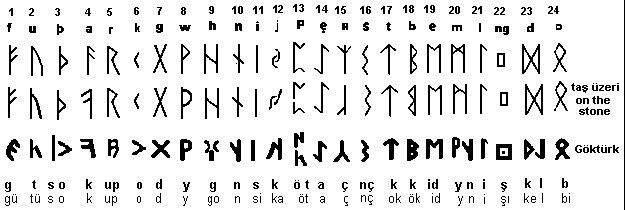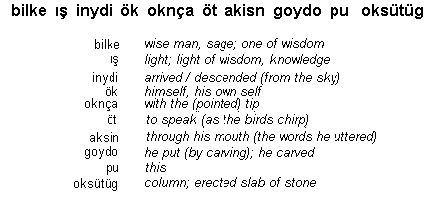The stone from Kylver farm in Stånga (Gotland).
Now, we can take a closer look at the photograph supplied on page 13 in Prof. Jansson’s book: The whole Primitive Norse rune-row is recorded on a stone, used as a side-slab in a sarcophagus, and found in Kylver farm in Gotland.

Since the characters from the 1st to the 6th spell out futhark, this word is used to denote the runic script. However, some characters are cut slightly different on the stone than what is shown within the text above: 
An identical form of the futhark character shown under #23 is also found in the Tonyukuk inscription, and commented upon on page 149 in Prof.Ergin’s book, although it is not given in the main list of symbols. In this book, it is stated to mean “head”. But for me, it signifies k+l. kel kelle, which is a synonim for the same word, and a composite form of these two distinct characters.
The same thing can be said for the character #13: It is a composite form of the symbols ![]() meaning (to) talk, (to) speak in English. It is also interesting if we consider the form as a pictoglyph of an open mouth.
meaning (to) talk, (to) speak in English. It is also interesting if we consider the form as a pictoglyph of an open mouth.
Now, I shall venture to read this 24-character rune row, from right to left, by applying the rules of reading Göktürk inscriptions: 
The meaning obtained thru reading the above piece, as if it were written in ancient Turkish, can roughly be rendered in today’s English as follows: The light of wisdom arrived/descended, he himself carved onto this erect stone, with ( the pointed tip of ) his arrow/dagger, the words he uttered/spoke through his own mouth.
I shall refrain from venturing into any philological or philosophical interpretations here. But, I would like to draw your attention to the emergence of the word O.d.ng, when the characters numbered 24, 23, 22 are considered in their runic namesakes. In the Scandinavian mythology, it was Odin, the Norse God who brought the gift of divine script to mankind. Then, the very name of the god in these three symbols read out as the light of wisdom (alias the divine reason), or the sage/lord of light in ancient Turkish… The readers further interested in this subject should get in touch with me.